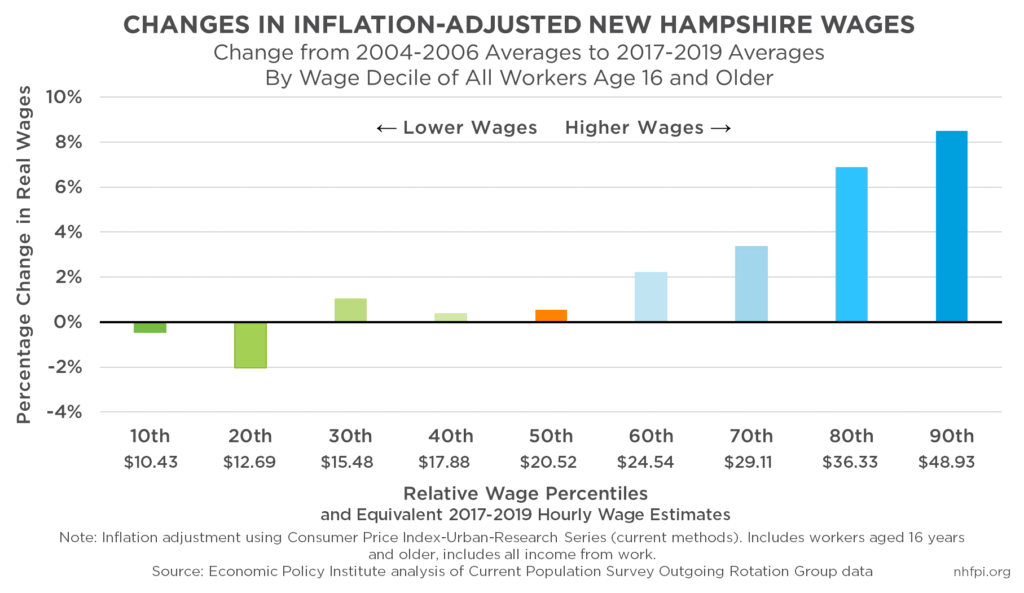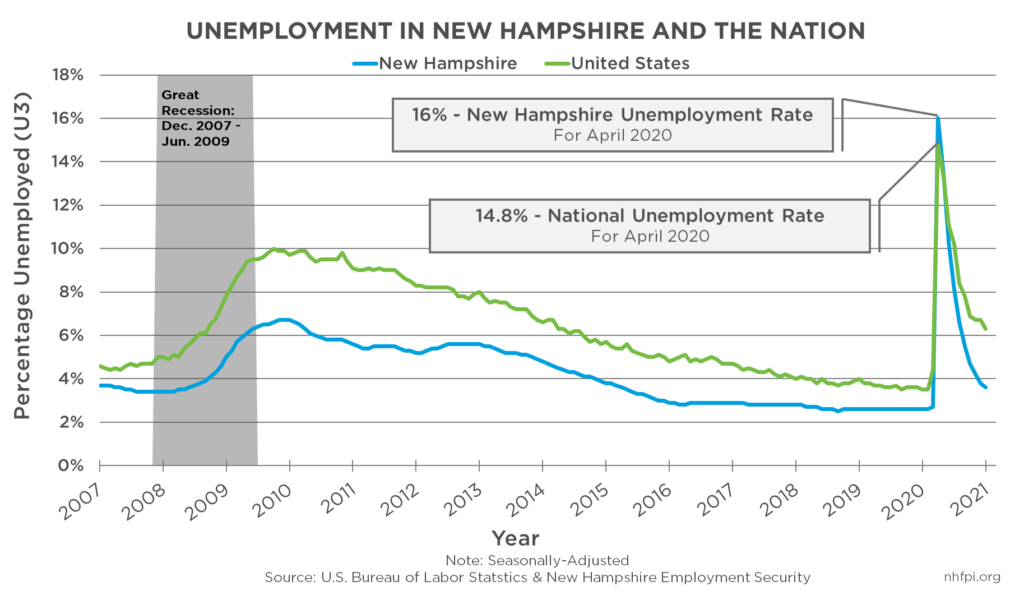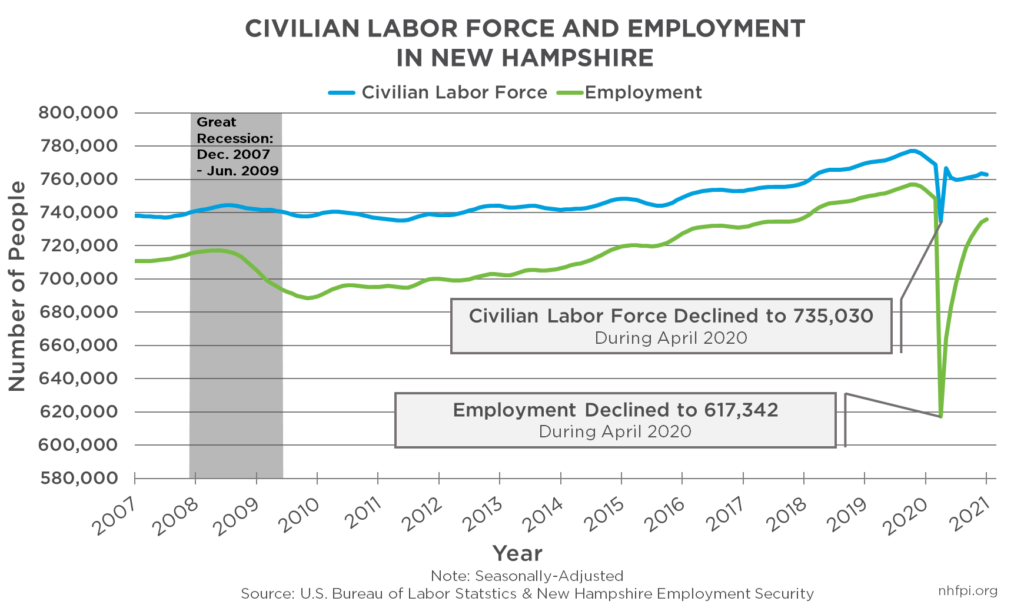In the year since the onset of the COVID-19 pandemic in New Hampshire, hardships facing Granite Staters have been caused by both public health risks as well as the economic crisis spurred by sudden shifts in the labor market and available jobs. While many of the most severe effects of the COVID-19 crisis have subsided, levels and the composition of employment have not yet returned to the pre-pandemic status. Additionally, many of those most impacted by the effects of the COVID-19 crisis may have been among the least prepared to weather the economic shock due to the uneven nature of the recovery from the last recession.
Economy Prior to the COVID-19 Crisis
Before the COVID-19 pandemic began in March 2020 in New Hampshire, the economy was continuing its recovery and expansion from the Great Recession. The Great Recession, which lasted from late 2007 to mid-2009, resulted in large shifts in employment and significant job losses. This recovery was uneven, as the positive impacts of the growing economy prior to the COVID-19 crisis took much longer to reach many Granite Staters, especially those earning lower wages and with fewer resources. This slow recovery left some individuals and families in New Hampshire less prepared or able to weather the economic impacts of the current COVID-19 crisis.
The decline of certain key industries in New Hampshire negatively impacted the wages of many workers. During the recovery from the Great Recession, significant job growth occurred in industries with average wages that were lower than the statewide average through 2019. Substantial declines in employment in manufacturing, a key industry which paid higher-than-average wages, occurred over this same period. Concurrently, wages and purchasing power, which can be described as “real” or inflation-adjusted wages, recovered unevenly at different relative wages in New Hampshire.
Before the onset of the COVID-19 crisis, the median wage, or 50th percentile wage, in the Granite State was equivalent to about $20.52 per hour during the 2017-2019 period; half of workers in the state earned more than this amount, and half earned less. Comparing real wages from before the Great Recession, in the 2004-2006 period, to the most recent three-year period before the pandemic, the 2017-2019 period, shows earnings among workers in New Hampshire who were paid the median wage or less experienced no clear wage growth. For much of the recovery from the Great Recession, the real wages and purchasing power of lower wages was declining, and only recently returned to their pre-recession levels prior to the start of the COVID-19 crisis. Over this same period, workers consistently earning higher wages in New Hampshire experienced clear and significant increases in their real wages and purchasing power compared to before the Great Recession.
Other challenges and disparities existed prior to the COVID-19 crisis. The most recent data from the U.S. Census Bureau’s American Community Survey show that, prior to the pandemic, median household incomes and per capita incomes were lower for households and individuals identifying as Hispanic or Latino, Black or African American, or two or more races in New Hampshire, respectively. Additionally, estimates show higher poverty levels for individuals identifying as Hispanic or Latino, Black or African American, or two or more races, as well as for children, those with lower levels of education, and part-time workers relative to the population as a whole. Families with children, with lower educational attainment, and those who rent their homes also faced higher relative poverty levels in New Hampshire. Regardless of other factors, families headed by single women had substantially higher poverty rates than other groups as well.
The uneven recovery that followed the Great Recession delayed the recovery from reaching Granite Staters with fewer resources and lower incomes. Additionally, disparities in poverty rates, incomes, and family compositions compounded the economic challenges facing many Granite Staters, leaving them more susceptible to the negative economic impacts of the COVID-19 crisis.
Employment Impacts of the COVID-19 Crisis
The current COVID-19 crisis has resulted in profound challenges to the economic well-being of many Granite Staters. The impacts of the pandemic and subsequent economic recession have been most acute for vulnerable populations throughout the state. Unprecedented declines in employment and historic increases in unemployment have been among the most dramatic economic impacts, resulting in part from limits to in-person interactions that have been integral to mitigating the pandemic.
These historic job losses have been most concentrated among industries employing workers who earn lower-than-average wages. The financial hardships of the COVID-19 crisis appear to be most acute among those with the fewest resources nationally, including those workers identifying as either Hispanic or Latino, or as Black or African American. These job losses are also represented through initial and continued unemployment claims, which spiked to unprecedented levels in mid-2020 and continue to remain elevated above pre-pandemic levels in New Hampshire. Breakdowns of initial claims by industry show that since March 15, 2020, the largest number of claims came from Granite Staters who worked in industries paying less than average weekly wages in New Hampshire during 2019, including Food Services and Drinking Places, Administrative and Support Services, Educational Services, and Social Assistance, among others. Ambulatory and Health Care Services paid higher-than-average wages, and experienced significant levels of unemployment insurance claims, mainly due to declines in hospital revenues in 2020.
National- and state-level unemployment rates peaked during April 2020. During this month, unemployment was estimated at 14.8 percent nationally, and in New Hampshire was estimated at 16.0 percent. During mid-2020, there were also significant declines in overall employment levels and the labor force size in New Hampshire, along with swift declines in the labor force participation rate and the share of the population employed. While many economic indicators have improved from their most depressed levels, this may not be indicative that the recovery thus far is reaching all Granite Staters.
Nationally in February 2021, about 40 percent of unemployed workers were considered “long-term” unemployed, meaning they had been without a job for at least 6 months. Additionally, many workers may have stopped looking for work due to the pandemic. Women, especially with school-aged children, appear to have been more likely to be detached from the labor force, contributing to labor force levels and labor force participation rates remaining below pre-pandemic levels.
As the size of the labor force is fundamental to estimating levels of unemployment, and the official estimated rate of unemployment only counts individuals in the labor force who are (or very recently were) actively looking for work and have not found employment, the reductions in unemployment rate levels may not be indicative of a recovery of the overall employment losses. The official estimate of unemployment does not capture individuals who have lost their jobs and stopped searching for work, referred to as discouraged workers, or individuals who are working part-time when they want to be working full-time.
Impacts of the COVID-19 Crisis on Individuals and Families
According to the New Hampshire Department of Health and Human Services, which manages many of the means-tested aid programs in the state (including the Supplemental Nutrition Assistance Program, Temporary Assistance for Needy Families, Medicaid, and child care assistance), the total number of unduplicated open cases for assistance has risen steadily since the COVID-19 crisis began.
Additionally, other high-frequency data are available through the U.S. Census Bureau’s newly-created Household Pulse Survey, which regularly collects weekly survey data with an aim to better understand the COVID-19 crisis’s effects on households. The survey indicated that nearly half of New Hampshire adults reported a loss of household employment income between March and July 2020. Additionally, at the end of 2020, about one in four households expected future employment income losses, and about one in three reported difficulty paying for usual expenses in New Hampshire. The Household Pulse Survey also estimated that from April 2020 to March 2021, between 4 percent and 12 percent of households in New Hampshire either sometimes or often do not have enough to eat for household members in the prior seven days. In addition to these challenges, over the past 12 months and since the onset of the crisis, prices paid for goods and services increased overall. Some of the more notable increases were in the costs of housing, overall household expenses, food, and personal care.
Looking Ahead
The COVID-19 crisis has resulted in significant challenges and hardships to individuals and families, especially those who were most impacted by the last recession. Despite the recovery from the most severe impacts of the pandemic, certain improving metrics may not indicate that the recovery thus far is reaching everyone impacted. Significant policy actions at the state and federal levels have spurred and supported the economic recovery so far while helping individuals and families weather this crisis. The recent passage of the American Rescue Plan Act will provide needed support to mitigate the negative economic impacts of the crisis, provide assistance during and after the COVID-19 crisis, help the overall economy recover and grow, and help ensure the current recovery can equitably reach all Granite Staters.
– Michael Polizzotti, Policy Analyst




